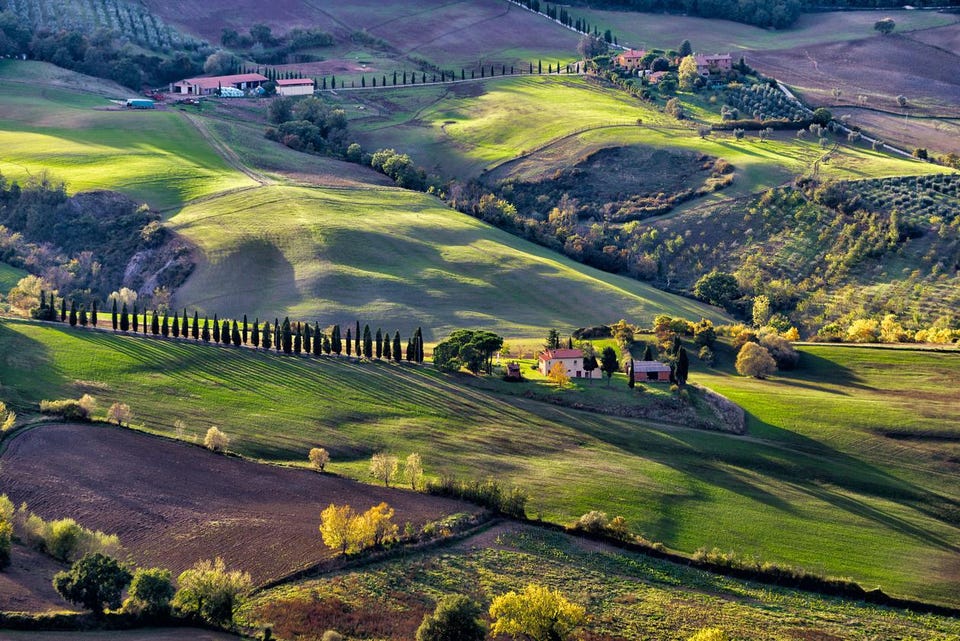Dining The ‘Tuscan Vine Germplasm’: Activating The Ancestor Vision At Avignonesi Cathy Huyghe Contributor Opinions expressed by Forbes Contributors are their own. I write about the people, business and politics of the wine industry. New! Follow this author to stay notified about their latest stories.
Got it! Aug 23, 2022, 03:05pm EDT | Share to Facebook Share to Twitter Share to Linkedin Maybe a decision is the right one for today. But is it right for your children, and for your grandchildren? That’s a question, and a guiding principle, that Virginie Saverys communicates continually to her staff at the Avignonesi estate in Montepulciano, which she acquired in 2009. “It’s an ancestor vision,” said winemaker and CEO Matteo Giustiniani, meaning a long-term vision that has transformed their piece of Tuscan soil from “something very close to the desert, or Mars” into the beauty it is now.
Typical hills of Tuscany, as seen from Montepulciano getty Aligned with that multi-generational vision has been an effort, started about five years ago, to rediscover indigenous grape varieties that are local to the area. The “Tuscan vine germplasm,” Saverys calls it. Her motivation to preserve the biodiversity of the area is an extension of the long list of environmental and cultural certifications Avignonesi has already achieved or is in the process of doing so, including vegan, organic, biodynamic, B Corp and other ESG (Environmental, Social, Governance) criteria.
Saverys is also mindful of the impact of impending climate change, and how their vineyard plantings and winemaking practices need to adapt to those changes. So, in addition to the Sangiovese and international varieties already planted on their vineyards in Montepulciano and Cortona, the team has recently been planting historical, autochthonous Tuscan white varieties such as Orpicchio (which has been cultivated in the province of Arezzo since at least the mid-19th century), Trebbiano Toscano, and Grechetto, which the team now calls by the local name Pulcinculo. Resuscitating those lesser-known varieties — particularly the Orpicchio — was a complicated and fascinating process.
Alessio Gorini, Avignonesi’s agronomist and COO, undertook a discovery process through researching historical documents. He said that the team recovered the Orpicchio plant material at the nearby Petrolo estate, which was mentioned in a 1854 treatise called “On the cultivation of vines in Tuscany. ” Gorini’s team grafted the vines directly in the field onto rootstocks planted in 2018, and began to observe and learn the plants’ behavior.
MORE FOR YOU Hendrick’s Gin And Katz’s Delicatessen Announce An Unusual Collaboration Bubby’s Chef Ron Silver Shares His Secrets For Perfect Pancakes This Northwest Brewery Has A Brilliant Side Hustle “The must yields are very low, probably one of the reasons for the abandonment of this variety,” Gorini said. “The aspect that struck us most about Orpicchio is its ability to maintain a marked acidity even at an advanced ripening stage. It is still too early to draw any conclusions from this, but it really does seem suited to producing white wines with excellent ageing potential.
” Turning to the red grapes, the more ancestral echoes of the “Tuscan vine germplasm” begin to resonate from the names and pronunciation of the grapes themselves: Canaiolo, for example, Gamay del Trasimeno, Mammolo, and Ciliegiolo. Gorini (the agronomist) and Giustiniani (the winemaker) seem to offset each other’s skillsets in their description of each of the indigenous Tuscan grapes now planted at Avignonesi: For starters is Gamay del Trasimeno, perhaps one of the most widely planted grapes in the world under the names Grenache, black Alicante, Cannonau or red Tocai. It has been cultivated in the nearby Lake Trasimeno area since the fifteenth century, producing highly aromatic and versatile wines in the both red and rosé styles.
Mammolo is also widely planted, specifically in Montepulciano and other Mediterranean areas such as Corsica, where it is known as Sciaccarello. Avignonesi has sourced plantings of Mammolo vines from different areas of Tuscany, beyond and in addition to Montepulciano. On the other hand, Gorini and Giustiniani describe Canaiolo’s “undiscovered potential” as both a blending grape to complement Sangiovese for its sweetness and roundness, and as a single-varietal expression with a unique character all its own.
Ciliegiolo, though delicate to handle, offers a soft and suave profile, and makes for an interesting expression of rosé. The choice of any of these varieties — from Orpicchio to Canaiolo — was not so obvious, Gorini and Giustiniani said. “The greatest effort was to try to perceive the personality of each grape variety within our context and imagine a harmonious coexistence between them.
” Follow me on Twitter or LinkedIn . Check out my website or some of my other work here . Cathy Huyghe Editorial Standards Print Reprints & Permissions.
From: forbes
URL: https://www.forbes.com/sites/cathyhuyghe/2022/08/23/the-tuscan-vine-germplasm-activating-the-ancestor-vision-at-avignonesi/



